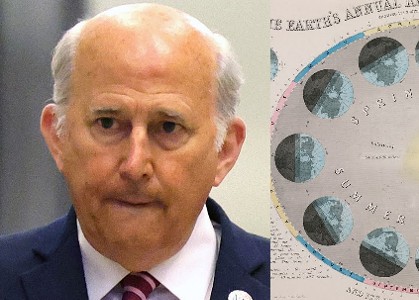At a congressional hearing Louie Gohmert, a Texas Republican House Representative posed a question to an official in the Bureau of Land Management. Why can’t we change the orbit of the Moon and the Earth to reverse anthropogenic climate change? The question he actually posed goes like this:
“Is there anything that the National Forest Service or Bureau of Land Management can do to change the course of the Moon’s orbit or the Earth’s orbit around the Sun?”
As crazy as this question is, so is the so-called expert from the Forest Service’s response:
“I would have to follow up with you on that, Mr. Gohmert.”
Really, there’s a follow-up to this imbecilic question posed by a “learned” member of the U.S. Congress?
Here are some basic facts about altering our planet’s position in the Solar System.
A move of three million kilometres further away from our current orbit around the Sun could in theory lower global average atmospheric temperatures by 3 Celsius (5.4 Fahrenheit). How so? For the same reason that Mars being further from the Sun gets less solar radiation than Earth, an increase in Earth’s orbital distance would diminish the amount of solar radiation striking the planet’s surface and cause our atmosphere to cool.
Why would we do this?
Our current global average temperature has risen in the last century by close to 1 Celsius (1.8 Fahrenheit). The current global average today is 15 Celsius (59 Fahrenheit). And based on current climatologists’ projections, by 2060, we should reach an average of 16 Celsius (61.8 Fahrenheit).
Is moving the Earth a simple solution?
In the Congressman’s mind maybe. By moving Earth back a few million kilometres, something we could conceivably do once a century or so, we could keep burning fossil fuels indefinitely, and keeping the cows farting away or until they come home.
But there is nothing simple about moving the Earth. The amount of energy needed to move Earth’s mass to a new orbit just a fraction of the distance proposed would be equal to thousands of times the amount of energy we humans produce today. We wouldn’t be able to do it with all the nuclear bombs in our global arsenal. Nor would we be able to do it using the thrust of thousands upon thousands of rockets equivalent in size to the Saturn V or Space Launch System. The likelihood of ever achieving that level of energy production within the next several centuries and beyond is inconceivable.
Is there another way to move the Earth?
Conceivably we could use orbital mechanics to push Earth further away from the Sun. But this couldn’t be done with one asteroid or another celestial object that we could conceivably manipulate. But first, we would have to capture such an object and redirect it towards Earth. And woe to us if we should misfire and the object strikes the Earth to cause an extinction event. And even if we could do it with a few asteroids it wouldn’t be enough. In fact, the entire mass of the Asteroid Belt is equal to 5% of the Moon’s mass, and if were to redirect all of the Belt the most we would move the Earth would be three-quarters of a million kilometres further from the Sun, one-quarter of our objective.
Could we change the Sun to mitigate global warming?
The Sun is not constant. It changes. Our celestial best friend and neighbour is slowly getting larger as it ages. There are some who deny climate change is caused by human activity. They point to physical changes in the Sun like sunspot minimums and maximums as contributors to atmospheric warming. But sunspots have nothing to do with the Sun growing over time. Based on our current understanding of solar dynamics, in the next 100 million years the Sun’s expansion will lead to an increase of 1% in solar radiation striking our planet.
At the current rate of greenhouse gases being added to the atmosphere from human activities, we will produce the same retained solar energy effect as a swelling Sun and do it in a few centuries.
So why not other solutions to atmospheric warming?
I’m talking about space mirrors or a space sunshade, an idea that has been bandied about within the engineering community going back a few decades. In 2016, the BBC published an article that described a proposal by James Early back in 1989 to build a 2,000 kilometre-wide space umbrella for diverting the Sun’s energy from striking the planet’s surface. Early thought we could source all the material needed from the Moon which would be much easier to get into orbit than if launched from Earth’s deep gravity well. The structure would be built in segments and assembled in space where it would be positioned far enough from the Earth to emulate a solar eclipse. The BBC article doesn’t mention the cost. And nor does it talk about the potential for the structure to fail and what that would suddenly do to an Earth now dependent on this enormous sunshade. Imagine how quickly the cooling would be reversed by a return to peak solar radiation striking the planet’s surface.
Another geoengineering idea that the Congressman didn’t suggest is one that Harvard University, Bill Gates and a few others have proposed. A pilot project to increase particulate matter emissions in the stratosphere to do artificially what large volcanic eruptions have done in the past has been proposed by Harvard. The proponents of this cite a recent example: Mount Pinatubo in the Philippines. The volcano erupted in 2001 and emitted an ash and gas cloud that reached as high as 50 kilometres (31 miles) in the stratosphere. Upper atmospheric winds soon disbursed the particles and gases (sulphuric acid droplets) planet-wide forming a haze that contributed to a drop in global average temperatures of 0.6 Celsius (1 Fahrenheit). The impact lasted almost two years. To create a Mount Pinatubo effect would require humans to release aerosols into the stratosphere continuously. This would involve the building of a dedicated fleet of aircraft and no one has studied how it might alter other atmospheric conditions such as impacting wind and precipitation patterns.








